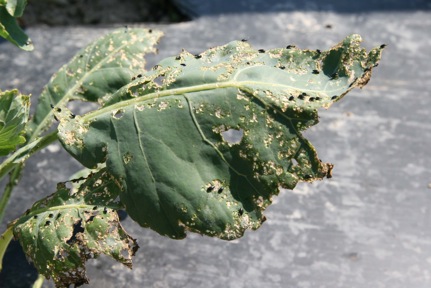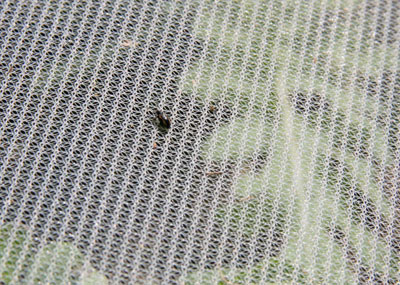
Pests: Crucifer Flea Beetle (Phyllotreta cruciferae), Striped Flea Beetle (Phyllotreta striolata), and Solanaceous flea beetles (in the genus Epitrix — E. cucumeris and E. fuscula)
Pest/disease identification and lifecycle, most common symptoms and crops affected:
In colder climates such as the Northeast, the crucifer flea beetle (Phyllotreta cruciferae) and striped flea beetle (Phyllotreta striolata) are two of the first we’re likely to encounter in the field, as their preferred food source, brassicas, tend to be planted out earlier in the season than other crops. The crucifer flea beetle is uniformly black and shiny, and about 2 millimeters in length. The striped flea beetle, as the name suggests, has two yellow stripes on its back. These flea beetle species and their damage to brassica crops are probably the best known to most growers, though other species also show up as pests on other crops. In particular, solanaceous flea beetles in the genus Epitrix (E. cucumeris and E. fuscula) are typically the culprits of feeding damage on nightshade crops, including tomato and eggplant. Epitrix species are very similar looking to the crucifer flea beetle, and with their small size and jumpy nature you cannot easily distinguish them.

These species of flea beetles all overwinter as adults in leaf litter at field edges, near to where they had been feeding the prior summer. The overwintered adults seek out new food plants in the spring, and lay their eggs in the soil starting in mid-spring. Larvae of the next generation may live in the soil for up to a month, feeding on fine root hairs, until they pupate and emerge on the surface as adult beetles. Though overwintered adults will continue to feed until they die, and new generations may appear before all of the prior generations die off, populations tend to appear in generational flushes. The potential constant presence created by generational overlap is a larger problem in brassicas, as the Phyllotreta species may have two or more generations emerge per season, and later generations are more likely to encounter young successions of brassica crops than solanaceous flea beetles would be to encounter young nightshade crops.
Crucifer and striped flea beetles feed on brassica crops as well as weeds that are in the same family, such as yellow rocket or wild mustard. Feeding damage on leaves is typically in the form of small round holes, chewed from the underside of the leaf, which can also be associated with a responsive discoloration in the surrounding leaf tissue of some crop types in some less common instances. Smaller greens with less waxy leaves (e.g., arugula, bok choy, tatsoi, mustard, Chinese cabbage, komatsuna) are preferred by the beetles to the waxy-leafed cabbage, kale, and collard types of brassicas. Waxy-leaved crops are most susceptible at cotyledon and seedling stages, when heavy feeding pressure may stunt or even kill the plants. On older plants with thicker leaves, feeding is limited more to leaf margins. These waxy-leaved crops may simply outgrow the beetle pressure, tolerating initial damage if it is not severe. Beetle-preferred root crops, such as radishes and spring turnips, may not have much yield loss from leaf damage, but holey leaves may impact saleability if the roots are sold bunched. Likewise, very little damage is typically tolerated by customers of smaller leafy greens crops such as arugula.
Solanaceous flea beetles first feed on solanaceous weeds, like horse nettle, before moving into fields where they may feed on tomatoes, potatoes, and eggplant, seeming to prefer eggplant of the three. They may also be found on less common crops such as ashwagandha. Because they do not feed on the roots or fruits of these crops (i.e., the parts harvested for sale), solanaceous flea beetles are only a concern in the early season when plants are most susceptible and heavy feeding damage from a large population could stunt or kill plants.
In addition to the characteristic “shot-hole” feeding damage on leaves caused by the adult flea beetles, a much more difficult to notice or quantify yield drag — or at least stressor to the crop — is caused by flea beetle larvae feeding on plant roots. With all types of damage, the pest population pressure makes all the difference. A small flea beetle population does not usually warrant control, but ignoring their presence may lead to larger populations in future generations.
Management options:
Scouting:
Because of their flea-like jumping, flea beetles can be difficult to count. This makes economic thresholds less useful, in addition to the difference in overall impact depending upon crop types and life stages. Yellow sticky cards can be used to monitor flea beetle presence, though feeding damage is commonly the first-noticed sign of their arrival.
Cultural:

To reduce and delay flea beetle invasion of spring crops, move them as far away as possible from the fields that were used for the same crop family last season. These beetles overwinter in field borders near the previous year’s crop, so planting the same crop close to where it was the prior year would ensure a high population in the spring. The same could be true if you have fields or field edges full of weeds in the same plant family as your crop, or move to a field that was planted to a brassica cover crop the previous year.
Consistently the best way to protect brassica crops from flea beetles is to place floating row cover or exclusion netting over the planting. It is critical to seal the edges immediately after seeding or transplanting, because brassica seeds germinate quickly and beetles rapidly find the cotyledons. Flea beetles can fit through extremely tiny cracks. Edges of the cover must be sealed on all sides using soil, or some other method, to ensure a consistent and complete “bead” of contact with the ground. Exclusion can be worse than ineffective in the absence of crop rotation if larvae of the next generation emerge from the soil under the cover, which now serves to protect them from any predation and restricts their feeding to only that crop.
Early plantings of attractive crop types or attractive weedy species may be used as a trap crop to reduce the population of flea beetles that would otherwise enter the primary crop. Examples of crops for early plantings include radishes or bok choy for brassica-feeding flea beetles; and eggplant for solanaceous flea beetles, which could also have a side benefit acting as a trap crop for Colorado potato beetles. For this approach to be helpful, the trap crop should be planted in advance of the primary crop. It must also be well monitored and the flea beetles should be killed effectively before they have a chance to migrate to your primary crop. While you may be able to harvest some of the trap crop, it is probably best to plan on killing it along with the beetles, as you may need to flame the crop and/or incorporate it to bury adult beetles. At the very least, plan to remove the crop entirely before too long, as you may be able to maintain the area plant-free for a couple of weeks after adult flea beetles have laid eggs in the soil around the trap crop, hopefully preventing a significant portion of the next generation from ever emerging.
Biological control:
There is at least one parasitoid wasp native to North America (Microctonus vittatae) that will attack flea beetles, however, it alone will not provide satisfactory population control. Some generalist predators such as green lacewings may also feed on some adult beetles and could be supported by interplanting flowering “insectary” plants, as some brassica growers may already do to support syrphid flies and other species that help to reduce aphid populations. Entomopathogenic nematodes can attack flea beetle larvae in the soil and may have the greatest potential of impacting the overall population, though it is always difficult to know what scale of population growth and associated damage was avoided by larvae that never emerged as adults.
Pesticides approved for use in certified organic production (as a last resort):
Kaolin clay, i.e., Surround WP, can be an effective crop protectant, but more so when used in conjunction with an attractive trap crop for a combined “push-pull” approach. Spinosad, i.e., Entrust (or Monterey Garden Spray for gardeners), is likely to be the most effective organic option for suppressing flea beetles and reducing damage. Pesticide materials with some residual effect, like Entrust, are often more efficacious on waxy crops like brassicas when applied with a spreader sticker adjuvant. Pyrethrin, i.e., PyGanic, is also effective at controlling flea beetles, while azadirachtin products showed poor to moderate efficacy in trials. Direct contact with beetles is important for both of these products owing to their short residual period, and re-application may be needed to achieve satisfactory results. Entomopathogenic fungus-based bio-insecticides, i.e., products containing species like Beauveria bassiana, may also be effective in reducing the survival of larvae in the soil.
Please note: This information is for educational purposes. Any reference to commercial products, trade or brand names is for information only, and no endorsement or approval is intended. Pesticide registration status, approval for use in organic production and other aspects of labeling may change after the date of this writing. It is always best practice to check on a pesticide’s registration status with your state’s board of pesticide control, and for certified organic commercial producers to update their certification specialist if they are planning to use a material that is not already listed on their organic system plan. The use of any pesticide material, even those approved for use in organic production, carries risk — be sure to read and follow all label instructions. The label is the law. Pesticides labeled for home garden use are often not allowed for use in commercial production unless stated as such on the label.
Informed by: Eric Sideman